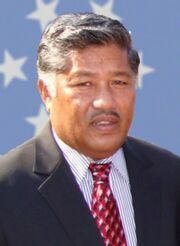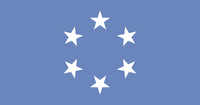| Languages | English (official at federal level) Ulithian, Woleian, Yapese, Kosraean, Pohnpeian, Chuukese, Marshallese, Chamorro (co-official at state level) Japanese, others (minority) |
| Capital | Kolonia |
| Largest city | Majuro |
| President | |
| Establishment | 10 May 1979 |
| Commonwealth membership | 2 January 1995 |
| Population | approx. 100,000 |
| Area | 1367 km² |
| Currency | Commonwealth dollar ($) |
| Subdivision of |
The Federated States of Micronesia is an Associate Member nation of the Commonwealth of Australia and New Zealand: it is fully part of the Commonwealth but has an increased level of autonomy in certain areas. It consists of the Caroline, Marshall, and Mariana Islands in the northwestern Pacific Ocean. Micronesia is a federal country made of six small constituent states. This federal structure reflects the unique history and culture of each island group.
History[]
Until 1979, the present islands of the FSM plus Palau made up the Trust Territory of the Pacific Islands, a vast swath of ocean administered by the United States of America at the behest of the United Nations. In 1979, the different island groups were granted self-government and set on the path to independence. Four of these (Pohnpei, Kosrae, Chuuk, and Yap) formed the Federated States of Micronesia, a federal government to replace the TTPI. Three other island groups (Palau, the Marshall Islands, and the Northern Marianas) opted not to join the federation. In 1982 Palau took the next step toward independence by signing a compact of free association with the USA, ending American trusteeship. However, that compact was never ratified. (In OTL it would not be ratified for another 11 years.)
On Doomsday, 26 September 1983, five nuclear weapons hit targets in the Micronesia region. One hit and wiped out Guam, which had not been part of the TTPI because of its much longer history of US colonization. Three hit American air and missile bases on the sprawling Kwajalein Atoll in the Marshall Islands. The atoll consists of tiny islets stretching out for hundreds of miles, so three missiles were necessary to take out all three bases. A fifth missile landed in the sea near Kwaj; it is believed that it was off target and intended to provide extra assurance that the Kwajalein bases would be destroyed.
Neither tourism nor foreign investment had played a great role in the islands' economies, which remained mostly devoted to subsistence agriculture and fishing. However, the governments had all been heavily dependent on American aid. As government services dried up, the islands became even more, well, insular. Most economic and political activity came to center on the village and the individual atoll.
The American Provisional Administration attempted to revive regional government by bringing back the Trust Territory of the Pacific Islands in 1987. Relying heavily on aid from New Zealand and Australia, the APA sent military and, far more importantly, humanitarian aid to the Micronesian islands and helped stabilize the state governments. Overall, ANZUS aid was well received. Palau, however, whose 1981 constitution had been the first of its kind to establish it as a nuclear free zone, resented the Cold War powers and blamed them for causing the disaster. Resentment was even stronger in the Marshall Islands, where most people blamed the US for the destruction of Kwajalein and the resulting fallout and pollution.
Nevertheless, the Federated States grew during these years. With ANZUS support, it was becoming an important way to maintain the connection with the rest of the Pacific. The Northern Marianas (which changed its name to the State of the Mariana Islands in 1987, claiming the dead landmass of Guam) joined the federation in 1988. The Marshallese government joined the FSM despite a fierce opposition movement in 1993. Palau was the only island to remain outside the federation. The FSM also sought to have a voice alongside the larger powers. Samoa had joined the ANZUS Commonwealth as an associate member in 1990, and Micronesia attained the same status at the start of 1995. This gave it a seat on the ANZUS Commission alongside Australia, New Zealand, the APA, and British forces in the Pacific; though as an Associate Member, its commissioner could not overrule decisions made by two of the three core ANZUS nations.
But by this time, the American Provisional Administration was already faltering. An attempt to reincorporate California and Oregon had failed spectacularly; Hawaii had voted to become an independent republic. Australia and New Zealand did not want to keep propping up an administration that was evidently losing the confidence of its own citizens. In May 1995, the APA dissolved, and the ANZUS Commonwealth became the Commonwealth of Australia and New Zealand.
In 1996, the allies signed a revised treaty to expand the scope of the ANZ Commonwealth. It created an elected House of Representatives and a larger and more powerful secretariat. Micronesia's government ratified the treaty, and it kept its status of Associate Member when it went into effect in 1997. Micronesia would be represented in the new chamber proportionate to its very low population, but it would be exempt from certain areas of legislation.
The new treaty was controversial. Very close ties to New Zealand and Australia meant that Micronesia would not have real independence, and many argued that membership should be replaced with Free Association, a much looser kind of connection that many other Pacific nations were pursuing. ANZ skeptics pushed for a referendum so that voters could decide on Micronesia's status. They succeeded only in 2001, by which time most people had become accustomed to membership in the Commonwealth. The vote was held across the federation with only two options, the status quo or Free Association. Despite a great and passionate effort at organizing by the Free Association side, the motion failed by a healthy though not overwhelming 57%-43% margin. Micronesia kept its status.
The status question has cooled off since then, but it remains an active issue that still sees debate in Micronesian politics. Membership affords economic and political advantages at the cost of a truly independent nationhood. The secession movement is strongest in the Marshall Islands. The Marshallese Independence Party, founded by James Matayoshi, is one of the major parties in the Marshalls' state government. It controlled the state legislature for the years 2004-2006, though it was unable to pass a successful secession bill. The MIP also regularly wins seats in the federal legislature and even sent an MP to Jervis Bay in 2007. The movement echoes the old grievances against the United States as well as newer ones.
A high point for the MIP came in 2005, the year that the ANZ Commonwealth and Hawaii came to an agreement on the uninhabited former US island territories in the Pacific. The MIP had long advocated the annexation of Wake Island (Enen Kio), considered a traditional Marshallese land. Wake had been a military base throughout the 20th century and been mostly destroyed by a Soviet nuclear warhead; nevertheless it remained of great symbolic importance to advocates of Marshallese sovereignty. The State of the Marshall Islands secured recognition of its claim in 2005. The MIP got a lot of credit for obtaining it, but it also meant that there was one less grievance against the Commonwealth; so the long-term impact was to dampen calls for independence.
Geography[]
The federation consists of six states:
The Mariana Islands were historically the most developed part of Micronesia and the most Americanized. However, they also suffered the most from the end of US aid after Doomsday and therefore suffered the greatest population loss.
The lifeless island of Guam occupies an ambiguous status within Micronesia. The Commonwealth has governed it, or what is left of it after the Soviet attack, as an external territory since the end of the American administration in the mid-90s. For almost as long, the Marianas have considered Guam to be their own territory and therefore part of Micronesia. Since the ANZC has much more capacity to patrol, explore and salvage the island's ruins than the tiny State of the Marianas, the state government has done little to press its claim. The FSM considers Guam to be an integral part of the Marianas that is under Commonwealth administration.
The Federal States do not encompass the entire Micronesia region. Belau, Nauru, and Kiribati are all republics in free association with the ANZC.
Government[]

former President Jibas (Labor, Marshall Islands)
Micronesia's government is based on the 1979 constitution, with some changes. The Council, in particular, was a post-Doomsday addition based on the Marshallese constitution.
Each state has authority over its local affairs. The lower house of the federal legislature, called the Senate, has six members elected by each state as a whole (one per state) and 25 elected from population-based districts. The Senate selects the President, who must be one of the six Senators. The upper house, called the Council, consists of traditional chiefs. It has no political power and acts as an advisory body.
The capital, Kolonia, is also the capital of Pohnpei state. The largest city is Majuro in the Marshalls, followed by Saipan in the Marianas. Before Doomsday, Saipan had been much larger than Majuro, but it was largely abandoned in the aftermath and never reached its original size. The capital has remained at Kolonia because of its central location.
The ANZC now handles many matters, such as foreign affairs, that were once the purview of the federation.
See also[]
| |||||||||||||||||
| ||||||||||








